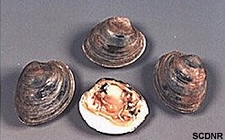Wildlife - Species

Hard Clam (Mercenaria mercenaria)
Description
Clams are bivalves, a group of mollusks with a shell consisting of two roughly equal-size valves that are hinged at one end. Concentric growth rings are usually visible between the margin of each valve and the hinge swelling, or umbo. External shell color is off-white or pale yellowish-brown, while the inside is white or pale yellow with purple margins. Hard clams have two short siphons through which water is filtered. The siphon which takes in water is called the incurrent, or inhalant siphon, and it lies on the ventral side (underside) of the clam. Water is expelled through the excurrent, or exhalent siphon, which is located dorsally (back side). Coloration of the siphons varies from cream to dark brown or black. Similar to other bivalves, clams have a fleshy tissue membrane, called the mantle, covering the internal organs. The mantle is in contact with the valves but not attached to them. Its primary function is to secrete the substances that make up the clam's shell. A hard clam also possesses a hatchet-shaped foot that it uses to move around and bury itself in the mud.
Preferred Habitat and Biology
Along the Atlantic coast, clams inhabit estuaries from the Gulf of St. Lawrence, Canada, to Florida. They also occur along the Gulf coast to the Yucatan Peninsula in Mexico. In the South Atlantic, hard clams are common in estuaries from the intertidal zone to depths of about 15 meters (50 ft) or more. They prefer muddy bottoms with loose shell and sand on top. Hard clams can bury to an average depth of 2 cm (1 in) in sand and 1 cm (0.5 in) in mud, with smaller individuals burrowing deeper than large ones.
The hard clam has a life history that is similar to that of the American oyster (Eversole 1987). Clams are also protandric. During the first phase of sexual maturity the clam functions as a male. Spawning is induced by rising water temperatures in the spring, when temperatures reach approximately 20°C. Because spawning activity is closely related to water temperature, times of spawning vary greatly with latitude. In South Carolina, the spawning season extends from spring until fall, with a pause during midsummer months. South Carolina clams are ready to spawn at two years of age. Females release eggs through the exhalent siphon, and fertilization by nearby males occurs freely in the water. Each female clam may release between 2 and 25 million eggs during a spawning season, depending on its size and condition. After about 10 hours, the embryo hatches and goes through a series of developmental stages before settling on the substrate. The hard clam has two non-shelled larval stages: a trochophore and an early veliger. Larvae propel themselves through the water column by use of a swimming structure, called a velum, until they finally adopt a benthic existence 20 to 60 days after hatching. Similar to oysters, the presence of other clams in the sediment induces settlement of clam larvae, resulting in dense patches of clams. Hard clams prefer sandy to muddy bottoms, especially those containing shell fragments near areas with turbulent currents and relatively high salinity. Small tidal creeks that are partly closed by oyster beds at the mouth appear to be one of the more productive habitats for this species. Although hard clams produce large numbers of eggs, mortality of pre-adult stages is extremely high. Once mature, clams experience lower predation pressure presumably due to a thicker shell.
Clams, like oysters, are filter feeders, passing water across the gills where food particles are removed. Food trapped on the gills is moved anteriorly to the clam's "mouth" by ciliary action. Large particles that the clam cannot eat are periodically expelled out of the mantle cavity into the water through the inhalant siphon, while waste products from digested food pass out the exhalent siphon as fecal pellets.
Species Significance
In the United States, hard clams have the highest dollar value of commercially harvested clams. They are sold under three categories based on size: littlenecks are the smallest and most expensive, cherrystones are medium-sized; and chowders, the largest, are least expensive and typically marketed to make clam chowder. In South Carolina, the same regulations that apply to the harvest of oysters apply to the harvest of clams. However, only one-half bushel of clams per person per day is legal. Similar to American oysters, clams perform the important ecological role of cleansing the water of suspended sediments through their filtering action.
References
Eversole, A. G. 1987. Species profiles: life histories and environmental requirements of coastal fishes and invertebrates (South Atlantic): hard clam. Biological Report 82(11.75). United States Department of Interior, Fish and Wildlife Service, Washington, DC.
Keith, W. J. and W. D. Anderson. 1995. Oysters and clams. Information and Education Series. South Carolina Department of Natural Resources, Charleston, SC.
